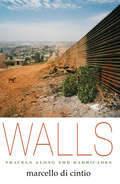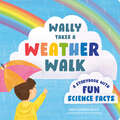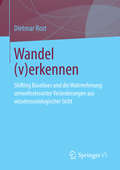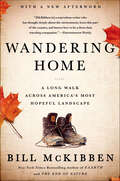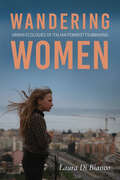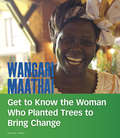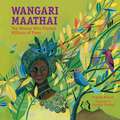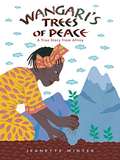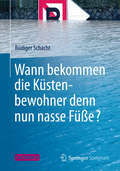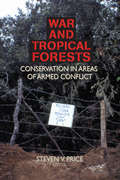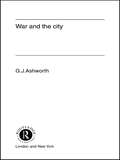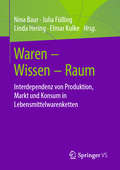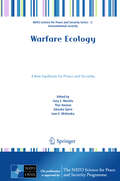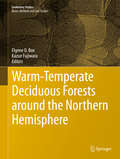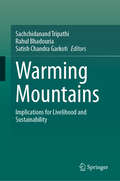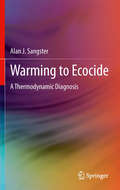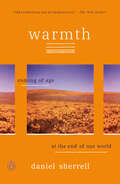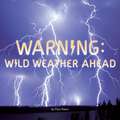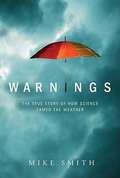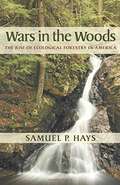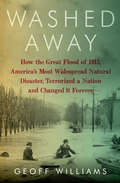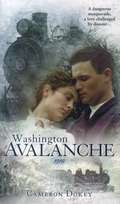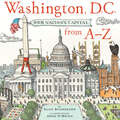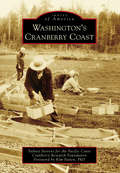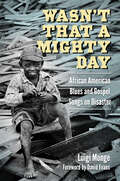- Table View
- List View
Walls: Travels Along the Barricades
by Marcello Di CintioWhat does it mean to live against a wall? In this ambitious first person narrative, Marcello Di Cintio travels to the world's most disputed edges to meet the people who live alongside the razor wire, concrete, and steel and how the structure of the walls has influenced their lives. Di Cintio shares tea with Saharan refugees on the wrong side of Morocco's desert wall. He meets with illegal Punjabi migrants who have circumvented the fencing around the Spanish enclave of Ceuta. He visits fenced-in villages in northeast India, walks Arizona's migrant trails, and travels to Palestinian villages to witness the protests against Israel's security barrier.From Native American reservations on the U.S.-Mexico border and the "Great Wall of Montreal" to Cyprus's divided capital and the Peace Lines of Belfast, Di Cintio seeks to understand what these structures say about those who build them and how they influence the cultures that they pen in. He learns that while every wall fails to accomplish what it was erected to achieve - the walls are never solutions - each wall succeeds at something else. Some walls define Us from Them with Medieval clarity. Some walls encourage fear or feed hate. Some walls steal. Others kill. And every wall inspires its own subversion, either by the infiltrators who dare to go over, under, or around them, or by the artists who transform them.
Wally Takes a Weather Walk: A Storybook with Fun Science Facts
by Bree Sunshine SmithEngage with the wonderful world of sunshine, rainbows, thunder, and snow as you learn fun facts with Wally! A first weather book for toddlers.Wally Takes a Weather Walk teaches toddlers the science behind what they see outside. What is wind? Why are there two rainbows? What makes snowflakes unique? Follow inquisitive Wally as he walks through summer, fall, winter, and spring, picking up facts about the seasons and weather conditions as he interacts with the natural world. Each page is a chance to spark curiosity around the magic waiting just beyond your front door. • A RAINBOW ASSORTMENT OF STEM FACTS: What does a toddler love more than asking &“Why?&” Here, weather questions are answered with scientific facts about each season. • A LIGHTNING-SMART AUTHOR: The only weather book for toddlers written by an Emmy Award–winning broadcast meteorologist, Bree Sunshine Smith (real name), accredited by the National Weather Association and the American Meteorological Society. • SUN, SNOW, AND ALL FIVE SENSES: A whimsical story helps toddlers stay engaged as they use all five senses to leap into a pile of leaves, taste snowflakes on their tongue, and spot a double rainbow!
Wandel (v)erkennen
by Dietmar RostAngemessene Antworten auf die Problematik von Klimawandel und Artenschwund verlangen eine gesellschaftliche Wahrnehmung von langfristigen Veränderungen in Natur und Gesellschaft. Das Buch fragt nach den Formen, Grenzen und Konsequenzen der individuellen und kollektiven Wahrnehmung von Wandel und eröffnet ein wissenssoziologisch fundiertes Verständnis der (Nicht-)Wahrnehmung vergangener wie auch zukünftiger Veränderungsprozesse. Dies erfolgt zunächst in einer theoretischen Perspektive durch die Zusammenführung von relevanten Gesichtspunkten aus der Erinnerungs-, Generationen- und Zeitforschung. Das Konzept der ,,Shifting Baselines" liefert hierfür einen Ausgangspunkt. Daran anschließend blickt das Buch anhand von Aufschlüssen aus qualitativen Interviews auf die Wahrnehmung von Wandlungsprozessen unterschiedlicher Dynamik - von langsamem, rapidem und krassem (d. h. katastrophischem) Wandel -, um schließlich die Frage der Varianz und historischen Veränderung der Wahrnehmung von Wandel zu diskutieren.
Wandering Home: A Long Walk Across America's Most Hopeful Landscape
by Bill McKibben“A marvelous writer who has thought deeply about the environment, loves this part of the country, and knows how to be a first-class traveling companion.” —Entertainment WeeklyIn Wandering Home, one of his most personal books, New York Times–bestselling authorBill McKibben invites readers to join him on a hike from his current home in Vermont to his former home in the Adirondacks. Here he reveals that the motivation for his impassioned environmental activism is not high-minded or abstract, but as tangible as the lakes and forests he explored in his twenties, the same woods where he lives with his family today.Over the course of his journey McKibben meets with old friends and kindred spirits, including activists, writers, organic farmers, a vintner, a beekeeper, and environmental studies students, all in touch with nature and committed to its preservation. For McKibben, there is no better place than these woods to work out a balance between the wild and the cultivated, the individual and the global community, and to discover the answers to the challenges facing our planet today.“A short, lovely chronicle of a long hike, during which McKibben meditatively reflects on the relationship between nature and humanity. Nature writing at its best.” —Kirkus Reviews (starred review)“An enamoring and discerning look at one man’s compiled thoughts and researched knowledge on the Adirondacks as he strolls through its dense forests.” —All Points North“[McKibben] writes with his usual wry, approachable power about the Adirondacks, his chosen home . . . The book could single-handedly spur a rush of tourism to the Adirondack area—it’s that good.” —Publishers Weekly (starred review)
Wandering Women: Urban Ecologies of Italian Feminist Filmmaking (New Directions in National Cinemas)
by Laura Di BiancoWandering Women: Urban Ecologies of Italian Feminist Filmmaking explores the work of contemporary Italian women directors from feminist and ecological perspectives. Mostly relegated to the margins of the cultural scene, and concerned with women's marginality, the compelling films Wandering Women sheds light on tell stories of displacement and liminality that unfold through the act of walking in the city. The unusual emptiness of the cities that the nomadic female protagonists traverse highlights the absence of, and their wish for, life-sustaining communities. Laura Di Bianco contends that women's urban filmmaking—while articulating a claim for belonging and asserting cinematic and social agency—brings into view landscapes of the Anthropocene, where urban decay and the erasure of nature intersect with human alienation. Though a minor cinema, it is also a powerful movement of resistance against the dominant male narratives about the world we inhabit.Based on interviews with directors, Wandering Women deepens the understanding of contemporary Italian cinema while enriching the field of feminist ecocritical literature.
Wangari Maathai: Get to Know the Woman Who Planted Trees to Bring Change (People You Should Know)
by Lisa A. CraytonWangari Maathai was a fierce protector of the environment and a couragous advocate for women's rights, especially in her native country of Kenya. Her journey from a girl of rural Africa to college professor, founder of the Green Belt Movement, and Nobel Peace Prize Laureate shows readers how little things can bring about big change.
Wangari Maathai: The Woman Who Planted Millions of Trees
by Franck Prévot&“Trees are living symbols of peace and hope.&” –Wangari Maathai, Nobel Peace laureateWangari Maathai changed the way the world thinks about nature, ecology, freedom, and democracy, inspiring radical efforts that continue to this day.This simply told story begins with Green Belt Movement founder Wangari Maathai&’s childhood at the foot of Mount Kenya where, as the oldest child in her family, her responsibility was to stay home and help her mother. When the chance to go to school presented itself, she seized it with both hands. She traveled to the US to study, where she saw that even in the land of the free, black people were not welcome.Returning home, Wangari was determined to help her people and her country. She recognized that deforestation and urbanization was at the root of her country&’s troubles. Her courage and confidence carried her through adversity to found a movement for peace, reconciliation, and healing. Aurélia Fronty&’s beautiful illustrations show readers the color and diversity of Wangari&’s Africa—the green trees and the flowering trees full of birds, monkeys, and other animals; the roots that dig deep into the earth; and the people who work and live on the land.
Wangari's Trees of Peace: A True Story from Africa
by Jeanette WinterAs a young girl growing up in Kenya, Wangari was surrounded by trees. But years later when she returns home, she is shocked to see whole forests being cut down, and she knows that soon all the trees will be destroyed. So Wangari decides to do something—and starts by planting nine seedlings in her own backyard. And as they grow, so do her plans. . . . This true story of Wangari Maathai, environmentalist and winner of the Nobel Peace Prize, is a shining example of how one woman’s passion, vision, and determination inspired great change. Includes an author’s note.
Wann bekommen die Küstenbewohner denn nun nasse Füße?
by Rüdiger SchachtAlltagsleben und Wissenschaft - ein ,,wunderbares" Beispiel für Parallelgesellschaften und in vielen Fällen ein Kommunikationsdesaster erster Güte: Längst versteht der Mensch auf der Straße den Wissenschaftler nicht mehr. Gerade am Beispiel der zum Teil hochemotional besetzten Debatte um die Klimaforschung zeigt sich, wie weit die beiden Welten auseinanderklaffen. Die vielfach schlechte Kommunikation der Methoden und Ergebnisse der Klimaforschung und die mediale Überspitzung der Vergangenheit rächen sich und kaum ein Mensch außerhalb des Wissenschaftsbetriebs überblickt noch die Methoden und Facetten der Klimaforschung. So versucht das vorliegende Buch die Debatte um die Klimaforschung wieder auf die Sach- und Faktenebene zu ziehen und einmal nachzuschauen, auf welchen Methoden die Ergebnisse der modernen Klimaforschung eigentlich fußen. Woher stammen die Daten, wie kann man die Ergebnisse zusammenführen und wie sehen die Schlussfolgerungen aus? Führende Klimaforscher schildern ihren Ansatz, der von der Datenerhebung bis zu den Klimamodellen reicht - und darüber hinaus! Mit einem Nachwort von Prof. Dr. Mojib Latif.
War and Tropical Forests: Conservation in Areas of Armed Conflict
by Steven PriceExplore the conservation implications of recent armed conflicts in the tropical forest regions of Asia, Africa, and Latin America! From the lowland rainforests of the Colombian Amazon to the rugged habitat of Rwanda's mountain gorillas, civil, ethnic, and international wars have had severe impacts on tropical forests and the communities they sustain. The reemergence of war and the persistence of its impacts have led many conservationists to reassess their efforts and adapt their strategies to a new set of responsibilities and urgent challenges. War and Tropical Forests: Conservation in Areas of Armed Conflict explores these challenges and the lessons learned by conservationists working in conflict zones around the world. It combines case studies and comparative analyses by leading experts in ecological research, environmental policy, and conservation field programs to provide insight into the environmental dimensions of recent social, political, and humanitarian crises. War and Tropical Forests reviews lessons learned from conflict zones around the world and explores: the potential of conservation to reduce the frequency, duration, and impact of war preparation of conservation programs and local communities for crises strategies for maintaining conservation capacity during times of conflict the underlying political and economic factors that fuel war legal mechanisms for addressing wartime damage to tropical forests building partnerships amidst civil strife and political upheaval This essential book also examines: the Indonesian military's role in illegal logging and deforestation violent conflict and gorilla poaching in the Democratic Republic of Congo armed movements and forest conservation in Nicaragua's largest protected area and much more! War and Tropical Forests also addresses the role of militaries in the inequitable control and illicit use of forest resources, the environmental impact of refugees, the growing social and environmental costs of efforts to eradicate drug crops, and the impact of conflict on protected area management in the habitat of Africa's endangered great apes. War and Tropical Forests is an essential resource for conservation practitioners and policymakers, as well as anyone involved with human rights, conflict resolution, rural development, international law, or foreign relations.
War and the City
by Gregory J. AshworthCities have evolved from small urban systems designed to withstand attack from without. The demands of the modern city have shifted the focus to the dangers of internal violence. War and the City analyses the role of cities in war and the effects of war on cities.
Waren – Wissen – Raum: Interdependenz von Produktion, Markt und Konsum in Lebensmittelwarenketten
by Elmar Kulke Nina Baur Julia Fülling Linda HeringDer Band betrachtet am Beispiel des Lebensmittelmarkts die drei Teilkontexte Produktion, Marktentnahme und Konsum in ihren wechselseitigen Handlungsbezügen sowie die Rolle von Macht und Wissen für die Koordination von Warenketten. Die Autorinnen und Autoren aus Geographie, Soziologie, Wirtschaftswissenschaften sowie der Stadt- und Regionalplanung widmen sich verschiedenen sich ergänzenden Aspekten der Koordination der Warenkette und der beteiligten Akteure von der Produktion, über die Logistik bis hin zum Handel und Konsum. Die Beiträge zeigen den unmittelbaren Zusammenhang zwischen Wissen und Handlungen der Akteure sowie deren Wirkungen auf die räumliche Organisation und Ordnung der Warenkette. Hinsichtlich der Rolle von Wissen geben die Beiträge eine Vielzahl an pointierten Analysen zu Teilaspekten der Gesamtinteraktionszusammenhänge.
Warfare Ecology
by Thor Hanson Gary E. Machlis Jean E. Mckendry Zdravko ŠpirićThe purpose of this book is specific and ambitious: to outline the distinctive elements, scope, and usefulness of a new and emerging field of applied ecology named warfare ecology. Based on a NATO Advanced Research Workshop held on the island of Vieques, Puerto Rico, the book provides both a theoretical overview of this new field and case studies that range from mercury contamination during World War I in Slovenia to the ecosystem impacts of the Palestinian occupation, and from the bombing of coral reefs of Vieques to biodiversity loss due to violent conflicts in Africa. Warfare Ecology also includes reprints of several classical papers that set the stage for the new synthesis described by the authors. Written for environmental scientists, military and humanitarian relief professionals, conservation managers, and graduate students in a wide range of fields, Warfare Ecology is a major step forward in understanding the relationship between war and ecological systems.
Warm-Temperate Deciduous Forests around the Northern Hemisphere
by Elgene O. Box Kazue FujiwaraWarm-temperate deciduous forests are "southern", mainly oak-dominated deciduous forests, as found over the warmer southern parts of the temperate deciduous forest regions of East Asia, Europe and eastern North America. Climatic analysis has shown that these forests extend from typical temperate climates to well into the warm-temperate zone, in areas where winters are a bit too cold for the 'zonal' evergreen broad-leaved forests normally expected in that climatic zone. This book is the first to recognize and describe these southern deciduous forests as an alternative to the evergreen forests of the warm-temperate zone. This warm-temperate zone will become more important under global warming, since it represents the contested transition between deciduous and evergreen forests and between tropical and temperate floristic elements. This book is dedicated to the memory of Tatsu Kira, the imaginative Japanese ecologist who first noticed and described this general zonation exception and who proposed the name warm-temperate deciduous forest.
Warming Mountains: Implications for Livelihood and Sustainability
by Satish Chandra Garkoti Rahul Bhadouria Sachchidanand TripathiThis contributed volume focuses on the sustainability of mountain ecosystems in the face of a changing climate. Its chapters highlight climate change impacts on the livelihoods of the people and communities that live in mountains and ways that these effects can be mitigated through adaptive measures. The chapters herein address a gamut of topics from use of remote sensing tools to assess changing ecosystems, disaster management in mountains, policymaking between institutions, and more. This book is suitable for students (undergraduate and postgraduates) of ecology and environmental studies/sciences, mountainous agriculture, mountain forestry, teachers, researchers, climate change scientists in academic and research institutions. It will also be useful to environmental management agencies particularly working towards sustainable development in mountainous regions, disaster management authorities, government agencies and policy makers.
Warming to Ecocide
by Alan J. SangsterDespite scientific evidence that business-as-usual is unsustainable, there is a huge and widespread inertia to 'greening' the planet. Warming to Ecocide considers climate change from a thermodynamic perspective and asks whether market-driven organisations have carried us to the point of no return through the flawed economics of endless growth. Warming to Ecocide begins by exploring the thermodynamic origins of climate change. It demonstrates that equilibrium thermodynamics can provide full explanations for the basic processes of life such as photosynthesis and metabolism, and that non-equilibrium thermodynamics is close to providing an explanation for how life started. Armed with a solid appreciation of the power of thermodynamics, the second half of Warming to Ecocide discusses whether multinational corporations have convinced the public that climate change is insignificant and thereby neutered any all attempts by governments to espouse environmentally-friendly policies. It then goes on to offer strategies whereby mankind may avoid propelling the global average temperature above the pre-industrial level by more than 2°C, which scientists view as a threshold presaging catastrophic run-away processes.
Warmth: Coming of Age at the End of Our World
by Daniel SherrellFrom a millennial climate activist, an exploration of how young people live in the shadow of catastrophe&“Strikingly perceptive.&” —Jenny Offill, author of Weather &“Beautifully rendered and bracingly honest.&” —Jenny Odell, author of How to Do NothingWarmth is a new kind of book about climate change: not what it is or how we solve it, but how it feels to imagine a future--and a family--under its weight. In a fiercely personal account written from inside the climate movement, Sherrell lays bare how the crisis is transforming our relationships to time, to hope, and to each other. At once a memoir, a love letter, and an electric work of criticism, Warmth goes to the heart of the defining question of our time: how do we go on in a world that may not?
Warning: Wild Weather Ahead
by Theo BakerBrave the elements while learning about all kinds of weather in this informative 8x8!Where does snow come from? Why does thunder crash? What's it like inside a tornado? In this easy-to-read 8x8 readers follow a team of scientists as they launch a weather balloon in various climates to discover the answers to these common questions and more. Despite increasing knowledge of weather patterns, many kinds of weather continue to mystify experts. Discover the wild world of weather—and don't forget your umbrella!
Warnings: The True Story of how Science tamed the Weather
by Mike SmithExperience the most devastating storms of the last fifty years through the eyes of the scientific visionaries who took them on and tamed them. Science and politics collide in this thrilling account of America's struggle for protection against the deadly threat of violent weather. Warnings tells the dramatic true stories of the unsung weather warriors who save innocent lives, often by risking their own.
Wars in the Woods: The Rise of Ecological Forestry in America
by Samuel P. HaysWars in the Woods examines the conflicts that have developed over the preservation of forests in America, and how government agencies and advocacy groups have influenced the management of forests and their resources for more than a century. Samuel Hays provides an astute analysis of manipulations of conservation law that have touched off a battle between what he terms “ecological forestry” and “commodity forestry.” Hays also reveals the pervading influence of the wood products industry, and the training of U.S. Forest Service to value tree species marketable as wood products, as the primary forces behind forestry policy since the Forest Management Act of 1897. <p><p> Wars in the Woods gives a comprehensive account of the many grassroots and scientific organizations that have emerged since then to combat the lumber industry and other special interest groups and work to promote legislation to protect forests, parks, and wildlife habitats. It also offers a review of current forestry practices, citing the recent Federal easing of protections as a challenge to the progress made in the last third of the twentieth century. <p><p> Hays describes an increased focus on ecological forestry in areas such as biodiversity, wildlife habitat, structural diversity, soil conservation, watershed management, native forests, and old growth. He provides a valuable framework for the critical assessment of forest management policies and the future study and protection of forest resources.
Washed Away: How the Great Flood of 1913, America's Most Widespread Natural Disaster, Terrorized a Nation and Changed It Forever
by Geoff WilliamsThe incredible story of a flood of near-Biblical proportions--its destruction, its heroes and victims, and how it shaped America's natural-disaster policies for the next century. The storm began March 23, 1913, with a series of tornadoes that killed 150 people and injured 400. Then the freezing rains started and the flooding began. It continued for days. Some people drowned in their attics, others on the roads when they tried to flee. It was the nation's most widespread flood ever--more than 700 people died, hundreds of thousands of homes and buildings were destroyed, and millions were left homeless. The destruction extended far beyond the Ohio valley to Illinois, Indiana, Michigan, Nebraska, Pennsylvania, Tennessee, Arkansas, Louisiana, Kentucky, West Virginia, New York, New Jersey, and Vermont. Fourteen states in all, and every major and minor river east of the Mississippi. In the aftermath, flaws in America's natural disaster response system were exposed, echoing today's outrage over Katrina. People demanded change. Laws were passed, and dams were built. Teams of experts vowed to develop flood control techniques for the region and stop flooding for good. So far those efforts have succeeded.It is estimated that in the Miami Valley alone, nearly 2,000 floods have been prevented, and the same methods have been used as a model for flood control nationwide and around the world.
Washington Avalanche 1910
by Cameron Dokey"Buried alive..." Desperate to escape her cruel stepbrother, Ginny Nolan races onto a train heading west to Seattle. On the train she meets Virginia Hightower, who is en route to Seattle to marry a man she's never even met. Eager to help her newfound friend, Ginny suggests that they switch identities -- to confuse her stepbrother who is in pursuit and to check out Virginia's fiance, Nicholas Bennett. It's the perfect solution for both young women -- until Nicholas appears on board and sweeps Ginny off her feet... Ginny must tell Nicholas the truth. Even if it drives him from her side. But not even in her wildest dreams can she imagine what is to come -- a roar in the night as a mountain of snow engulfs the train, testing the limits of human endurance, loyalty... and love.
Washington D.C. From A-Z
by Alan SchroederSee our nation's capital like never before!In almost 100 entries from A to Z discover little-known lore, hidden history, and quotable quotes about Washington D.C.Throughout the book, humorous full-color cartoons enhance the funny, strange, and intriguing details behind important landmarks and the people who have come to the capital to run the nation&’s business, celebrate, protest, live in the thick of it or just visit. From the aluminum tip of the towering Washington Monument to the marble bathtubs in the Capital building&’s basement, this book offers a top to bottom look at Washington D.C. and its eclectic history that will enchant visitors and locals alike. The end papers feature a comprehensive map of the District showing locations of key buildings including The White House, The Washington Monument, The Lincoln Memorial, The Martin Luther King, Jr. Memorial, and The Capitol building as well as many other important locations.A Junior Library Guild selection!
Washington's Cranberry Coast (Images of America)
by Sydney Stevens for the Pacific Coast Cranberry Research Foundation Kim PattenFor 100 miles along the western edge of Washington State, an unusual agricultural community hugs the Pacific shoreline. Bogs of bright cranberries stretch from the Long Beach Peninsula at the mouth of the Columbia River north to Grayland, Ocean Shores, and Copalis Crossing. Here, along this remote stretch of stormy seacoast, is a prime farming center for a fruit that grows in very few areas on earth. For countless centuries before pioneer settlement, indigenous peoples harvested the wild cranberries that thrived in boggy regions of the coast. When enterprising mid-19th-century settlers saw the possibilities for a vigorous cranberry farming venture, they faced many challenges before success could be achieved. Theirs is the story of hardworking, forward-thinking people who have become leaders in their field.
Wasn’t That a Mighty Day: African American Blues and Gospel Songs on Disaster (American Made Music Series)
by Luigi MongeWinner of the 2023 Award for Excellence for Best History in the category of Best Historical Research in Recorded Blues, R&B, Gospel, Hip Hop, or Soul Music from the Association for Recorded Sound CollectionsWasn’t That a Mighty Day: African American Blues and Gospel Songs on Disaster takes a comprehensive look at sacred and secular disaster songs, shining a spotlight on their historical and cultural importance. Featuring newly transcribed lyrics, the book offers sustained attention to how both Black and white communities responded to many of the tragic events that occurred before the mid-1950s. Through detailed textual analysis, Luigi Monge explores songs on natural disasters (hurricanes, floods, tornadoes, and earthquakes); accidental disasters (sinkings, fires, train wrecks, explosions, and air disasters); and infestations, epidemics, and diseases (the boll weevil, the jake leg, and influenza). Analyzed songs cover some of the most well-known disasters of the time period from the sinking of the Titanic and the 1930 Drought to the Hindenburg accident, and more. Thirty previously unreleased African American disaster songs appear in this volume for the first time, revealing their pertinence to the relevant disasters. By comparing the song lyrics to critical moments in history, Monge is able to explore how deeply and directly these catastrophes affected Black communities; how African Americans in general, and blues and gospel singers in particular, faced and reacted to disaster; whether these collective tragedies prompted different reactions among white people and, if so, why; and more broadly, how the role of memory in recounting and commenting on historical and cultural facts shaped African American society from 1879 to 1955.
